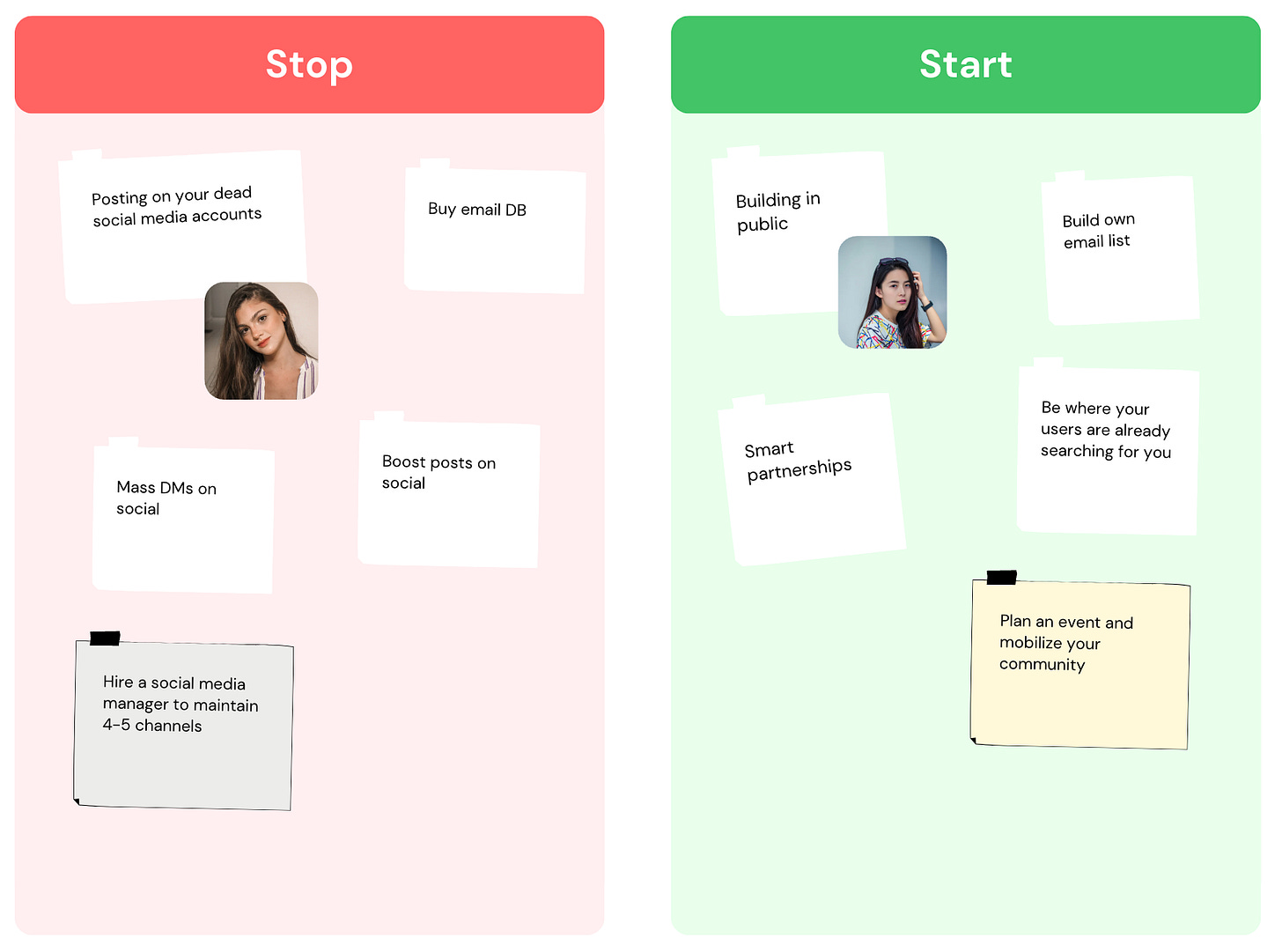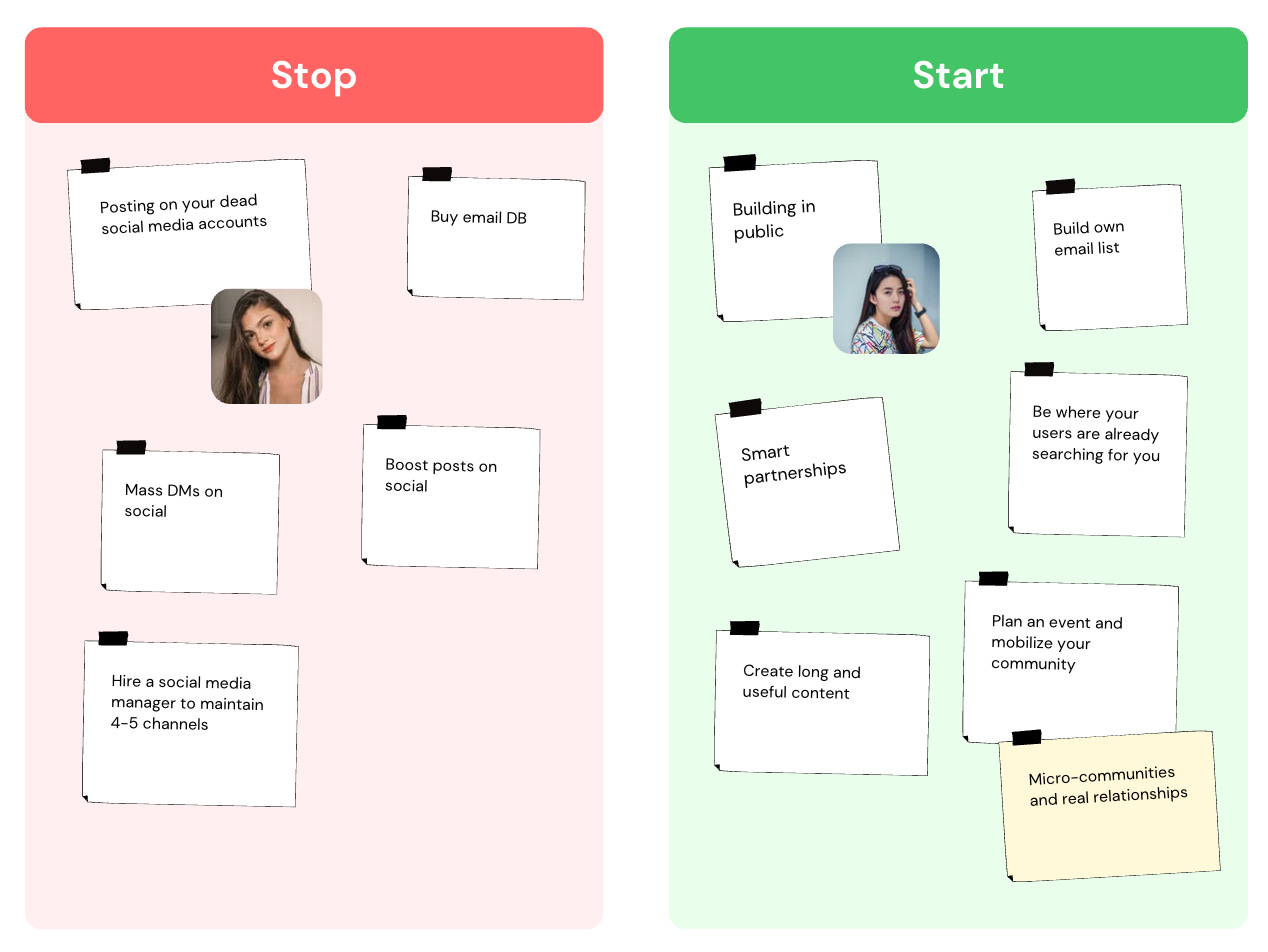Last week, I did a talk in front of 100 developers.
My mission was to help them gain traction in their side hustles.
I got lots of questions and thought I'd publish my talk here.
In case you're building something and you're early in the process - this is for you, too.
Let's go!
Anatomy of your first 10
Getting your first ten users (or dollars!) is usually easy, unless you're an absolutely anti-social animal, even in online circles.
Here's how you get your first ten users:
#1 - Mom
#2 - Girlfriend/Wife/Boyfriend
#3-4 - A couple of best friends
#5-10 - Folks from a group chat
There's nothing wrong with your mom being your power-user.
Maybe only one thing.
Maybe you didn't build something for folks like your mom.
10 → 100 → 1000
And that's when you're likely to hit a wall because although you got the initial sign-ups, it doesn't mean you can scale the same way.
Even if your F&F supported you by paying money, maybe it means just that:
They are a very supportive bunch.
To get your first 1000 users, you can't leverage your social connections any longer and have to do things at scale.
Let's explore what you could (and shouldn't!) do to do this cost- and time-effectively.
But before we do this…
Consulting Disclaimer
In normal life, there are dozens of business models from SaaS to brick-and-mortar. Their growth patterns differ. They don't have the same resources.
However, I've come to realize one peculiar thing: sometimes, the best ideas for growth hacks happen at the overlap of the industries and methods.
What if we apply this B2C tactic to our B2B team?
What if we treat our FinTech startup as a community business?
What if we test this unscalable approach to see what happens?
Although lots of these early-stage tactics belong to specific industries, I encourage you to think of them as generic and give this a mental spin.
As you go through the cases, think if any of these would work for your industry/niche. And then let me know in the comments.
In the meantime, here's a one-size shirt. I know there's no one-size-fits-all, but here's one.
Tactic 1:
Building in Public
If your personal social media accounts are clinically dead, or you've only been sharing deeply personal updates (dog pics, workouts, and occasional cakes), one or two posts on your new business venture won't move the needle for your biz.
Facts.
However, there is an alternative approach.
Try this:
Pick a platform that works for you
Make sure it's a fit for your product and audience (Software? X. B2B SaaS? LinkedIn. Consumer products? Instagram or TikTok).
Start documenting your journey as a founder
Start documenting your journey as a founder. Try building in public.
Building in public is a major movement.
By sharing what you build and what you learn along the way, you might not only get your first 1000 users but also build an audience along the way. The core of it is transparency and consistency. Don't expect magic in the first weeks, but the compounding effect will get you far. Especially if you're just starting.
I got inspired to build in public by Dave who I met at a conference last year. Dave started his blog Love in The Dumpster to document his entrepreneurship search (literally…). His project got 700k+ followers and was made into a Vice documentary.
Not a bad bonus.
For more inspiration, check out this article on Failory - it has plenty of examples and even other builders to follow.
Tactic 2:
Building your email list
You can buy pretty much anything.
An email list or an X account with followers. But do you want to do it?
I'm not even talking about the legality of the action.
My question is: is it going to be helpful?
Quick answer: no.
Every other week I hear one of my clients or colleagues saying that “email is dead", “email is going to be dead” or “email will definitely die when …. “.
Funny enough, you probably got this blog post by email.
Even today, email is one of the strongest owned media a company can build. If managed well, it's one of the best ways to maintain relationships and, ultimately, sell products.
We surveyed a list of our 50,000 email subscribers at my e-learning company last year. The content they were most excited about getting was tutorials and tips. But here's the punch line: the second on the list came promotions and discounts.
Our subscribers are sticking around waiting for the best opportunity to buy, and they are waiting for that discount or special offer email.
Some businesses are built entirely on email marketing. Check out Perfect English Grammar by a friend of mine Seonaid. Since 2017, she's been carefully curating a list that grew to almost half a million subs, and counting. This is a growing bootstrapped business, and email is their only channel.
It can be yours, too.
Tactic 3:
Smart Partnerships
I've gotten way too many DMs suggesting random partnerships that are not even a fit.
These deserve to die.
But there are smart partnerships.
When I see these around, it's like watching a happy couple walking down the aisle.
A real estate agent hooking you up with a vetted mortgage broker.
A car dealership getting you discounted insurance.
An Executive search company paired with a CV review service (affiliate deal, definitely)
To be successful with partnerships, think of ecosystems. All products and services live within clusters - do not confuse them with industries.
What ecosystem are you a part of? Who is your “match made in heaven"?
Reach out to them, and make this a truly visible winning partnership.
All products and services live within ecosystems.
What ecosystem are you contributing to?
Tactic 4:
Be where you are searched for
When I opened a Coliving company a few years back, I quickly understood that the name of the game with a physical business was Occupancy Rates.
Fixed costs piled up, and if we didn't sell rooms or coworking seats by Monday, the week would be pretty much lost. That's a 1/4 of a month. 25% of the revenue.
I also understood that the quickest way to bring the new users was to get in front of the ones who have an immediate need: they are searching, and they are not doing it in Google (ok, not all of them).
There were many platforms our customers used to discover us:
Maps (not just Google maps)
Review sites
Startup directories
Accommodation booking platforms
Real estate platforms (for longer stays)
Tags on social media
Blogs - your typical listicles (“7691 best coworking space in Liverpool")
And more!
This idea applies to many businesses. We sometimes go the hardest way to be visible and opt for a “push” advertising to our customers. The easier is to get free ads on all of these platforms, because it contributes to your branding while getting you customers.
Your community is already looking for you.
Let them find you faster.
It works all the time, with the only downside: time. Assuming you're just starting, you should have more of it than others.
If you think outside of the box, you should get yourself 10+ free slots online. And sometimes, if you're lucky, this leads to media attention, improved SEO, and long-term visibility.
Tactic 5:
Plan a launch party
I give so much attention to social because I consistently see startups falling into this trap.
It seems so easy.
And it also seems a compulsory element.
As essential as incorporation of your business: incorporation of your TikTok.
But it's not. It's a massive drain of resources, especially when you have little to none.
I frequently see founders hiring freelancers or agencies to maintain social, and I always want to stop them, because ROI on this is extremely low.
Instead, especially for B2C/B2B2C companies, it's always a good idea to plan a launch or an event and mobilize a crowd.
You can either run it in-house, like we always did at Art Heroes, or launch it within an ecosystem like ProductHunt.
Here are some other places where you could launch a product or a service:
Kickstarter + alternatives
ProductHunt
BetaList
Startup Stash
Hacker News
AppSumo
Indie Hackers
Launched!
Make.rs
SaasWorthy
The mechanics of a successful launch event:
Set a date on a calendar
Plan what happens on a date, and what are the bonuses and expectations on your end.
Reverse engineer the build-up to the event
Increasing the mental availability means growing real fans
Tactic 6:
Create unique & useful content
One of my mentors likes to say:
The best landing page of a startup is its’ product.
The best landing page of a startup is its’ product.
He's tested this multiple times by building successful businesses and monetizing only when the community got onboarded.
If you can be patient, you can do just this.
If not, try building tools, videos, and even long reads that are aligned with your product, and help you build authority.
Ubersuggest lets you use the free search and analytics for as long as you wish. Most of their features are free, in the market where the same is sold for a top dollar by their competitors (SemRush and AHrefs).
In a totally different market, my client Blockonomics became niche-famous by building a Bitcoin search tool.
It brings about over 20,000 organic views, builds brand awareness, and drives leads.
Your early content needs to lead with quality.
It's building your bottom line, reputation, and sustainable growth foundations.
Tactic 7:
Tackle micro-communities
One of my clients, a FinTech startup Savii, did this brilliantly.
Their core product was a family card for teens, but moms were the power users. Savii team realized early on that moms are in charge of allowances, school money, holiday gifts, and even financial literacy at home.
So Savii went to Facebook groups, and simply… asked!
They didn't pitch. They showed up as they are.
It was almost like "building in public”, but within a few communities.
Results?
This 👇
They went viral in a small-ish community and built a larger user base than they could serve. Their users became their ambassadors.
Just like this:
To summarise.
A lot of first-time founders do “top-of-mind” growth tactics.
It's likely to either burn a lot of cash, or time, or both. And while this might work for some, it's not a silver bullet for most.
Here's my “Stop list” with some of the most ineffective "First 1000” strategies.
Instead?
Growth can be smart and sustainable.
Just like this:
Hope you learned something. If someone you know needs to see this, forward them this article (and TYVM!).
Now over to you:
Did you get that 1000? What helped you on the way?
Share in the comments, because I'm going to be updating this post with more examples.





















